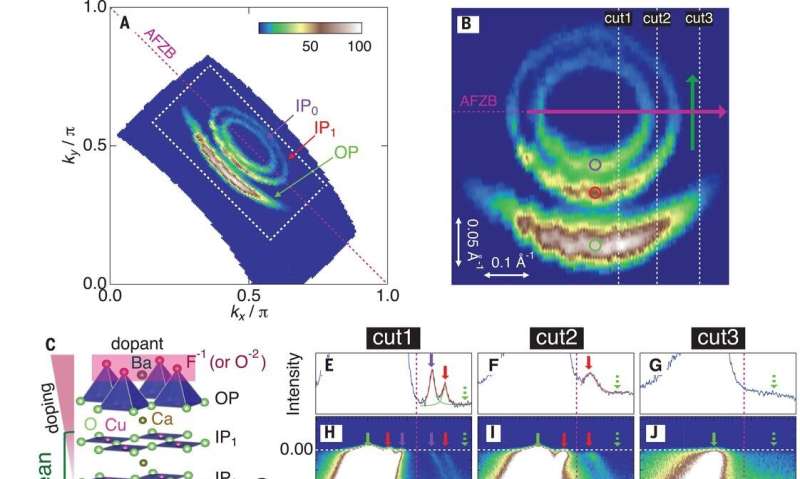August 14, 2020 report
Investigation of five-layered cuprate reveals Fermi pockets

A team of researchers affiliated with a host of institutions in Japan and one in the U.K has observed Fermi pockets during experiments with a five-layered cuprate, confirming theories. In their paper published in the journal Science, the group describes their study of the cuprate Ba2Ca4Cu5O10(F,O)2 and what they learned about superconductivity. Inna Vishik with the University of California Davis, has published a Perspective piece in the same journal issue giving background on superconductivity research involving cuprates and their transition temperatures and outlining the work done by the team in Japan.
Cuprates are defined by their anionic copper complexes. They also have the highest transition temperatures for superconducting materials. Superconductors are, of course, materials that allow electricity to pass through them without resistance. Most materials must undergo treatment to become superconducting, such as being chilled. Such materials thus have a transition stage when they change from a regular conductor to a superconductor.
As Vishik notes, prior research has shown that cuprates possess some of the highest transition temperatures, making them inviting targets of investigation. Over the past several years, a considerable amount of work has shed light on the factors that contribute to superconductivity, but thus far, it is still not very well understood. Vishik notes that researchers have studied just a few cuprates, despite the hundreds of cuprates to choose from. It was for this reason that the team in Japan chose to study a cuprate that has seen little to no research, the quintuple-layer cuprate, Ba2Ca4Cu5O10(F,O)2.
The work involved doping the cuprate in a Mott insulator—a task that in the past has proved challenging. Theory has suggested that if a small concentration of charge carrier is added to a Mott insulator, Fermi pockets should become observable. The researchers were able to overcome problems experienced by other researchers due to their choice of cuprate. It has a unit cell with five copper oxide planes instead of the normal two, making it much easier to observe the pockets as they became visible. The researchers were able to see two of them in their work, bolstering the theories that predicted them.
More information: "Observation of small Fermi pockets protected by a clean CuO2 sheet of a high-Tc superconductor" Science (2020). science.sciencemag.org/cgi/doi … 1126/science.aay7311
Journal information: Science
© 2020 Science X Network




















